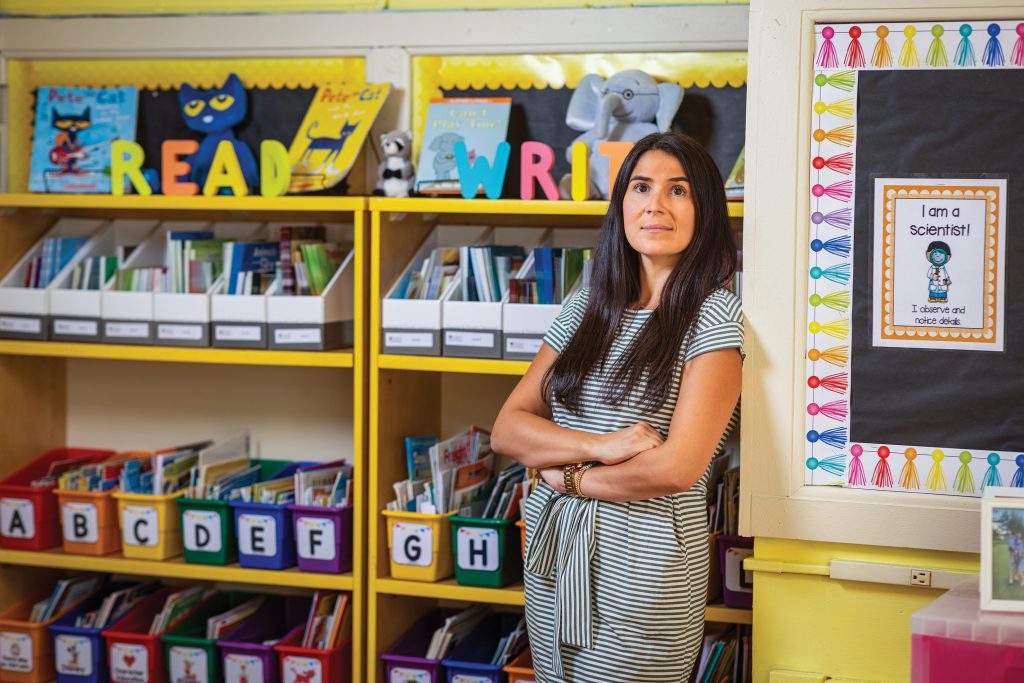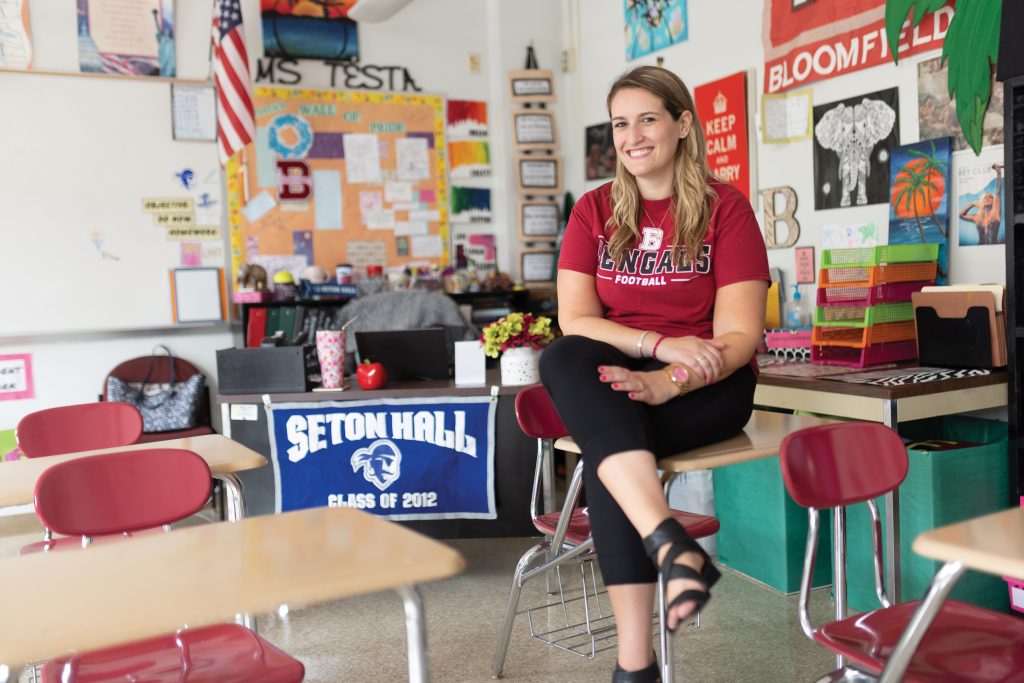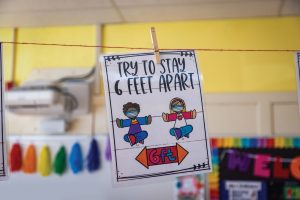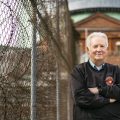By Kevin Coyne
First-grade teacher Mrs. Cashin — Dina Cashin ‘08/M.A. ‘14 — misses her rug. It was blue, dotted with big colorful circles, and it covered a corner of her first-grade classroom in the Aldene Elementary School in Roselle Park, the school where she was once a first-grader herself and where she has taught for 13 years, alongside some of the same teachers who once taught her. The rug was where students sat cross-legged around her, peppering her with questions, asking “Mrs. Cashin, what about … ?” during the 15-minute mini-lessons she liked to teach about math or phonics or whatever else they were learning that day.
“It’s a lot to ask a first-grader or any elementary school student to stay in their seat at their desk all day,” says Cashin ’08/M.A.’14. “They’re meant to move around.”
Her rug is gone now, along with the shoulder-to-shoulder sessions it enabled, a casualty of the COVID-19 pandemic’s social distancing restrictions, and she doesn’t know when it will be back.

In March 2020, the activity at the heart of education — a cluster of people in a room, talking — suddenly became perilous. School became computer screens, video sessions, 6-foot tape measures, plastic shields and masks. “Distance” morphed from noun to adjective, as “distance learning” became the new paradigm. “Hybrid” and “cohorts” entered the daily vocabulary. What letter does your last name start with? Let’s see, that means Mondays and Thursdays for you. Please come pick up your Chromebook. Do you need a hot spot for Wi-Fi? Yes, Zoom again.
Everything about teaching had to be reconceived, re-engineered, redeployed in the pandemic. So how did teachers manage? What did they do without their rugs? We talked to five of them, from different grade levels and different regions, and they had plenty to say. They are teachers, after all, and they have these lessons.
Just Like Starting Over
“I felt like a first-year teacher again,” says Ricky Harzula ’13, who has in fact been teaching for eight years in Detroit, the last six at the Jalen Rose Leadership Academy, a public charter high school founded by the city native who was a basketball star at the University of Michigan and in the NBA. “I felt like I didn’t know what I was doing at all.”
“To be honest, I don’t think any of us really knew at all what we were doing,” Cashin says. “We were all first-year teachers again.”
Everybody scrambled those first few months, although it helped if you were at a tech-savvy private school in Seattle with close ties to Microsoft, the local computer behemoth. “We had a lot of training prior to going remote — we were not only able to train ourselves but also to train the boys,” says Megan Marenco ’12/M.S.’14 who teaches biology to sophomores at O’Dea High School, a Catholic boys’ school. A snow day before lockdown even gave the school the chance for a dry-run virtual trial day first. “We knew it was eventually coming, we just didn’t know when.”
Technology has long been in the classroom, but teachers — guided by their own interests, philosophies and abilities — often had a choice about how much to use it. Now they had no choice — it was virtual or nothing.
“Breakout rooms, jam boards — some teachers were hesitant to try these with kids before,” says Desiree Testa ’12/M.A. ’15, who teaches world history to freshmen at Bloomfield High School, which had started issuing a Chromebook laptop to each student several years before the pandemic. The second degree she earned — a master’s in instructional design and technology, a subject she also now teaches at Seton Hall — proved especially apt this year. She turned her dining room into her classroom, with two screens open: one for the Google Meet sessions, and one for work on presentations.
“I’m the type of person that jumps right in — if it works, it works, and if it doesn’t, then we do something new tomorrow,” she says. “I’ve adapted all my old lesson plans for this abundance of technological resources. I think the hardest part for me is figuring out which activity to use and which not to use, because there’s only so much time.”
Beyond Zoom
Everybody had to get used to conversing through a screen. “We were nervous about confidentiality at first,” said Brad Harris ’07/ Ed.S.’10, a school psychologist at Middlesex County Vocational and Technical School in East Brunswick. “But you kind of reach a point where they need this support, so how else are you going to give it to them?”
But there also comes a point where … enough already. “I can’t sit in front of a computer doing one task for 80 minutes, I don’t know how we expected 14- to 18-year-olds to do the same thing,” Marenco says. Her school ultimately cut its 80-minute classes to 55 minutes. “The main reason we truncated the school day was student mental health and screen time. The main goal was reducing screen time.”
Remote sessions were a necessary but not sufficient condition for learning. “Some students excelled and some students struggled, and that was just the reality of it across the board, and it’s just the different types of learners kids are,” Testa says. “Some are more disciplined being home and having the leeway of getting things done on their own time and other students need that direct interaction. But instead of me tapping on their desk and saying, ‘Focus,’ they were busy playing a video game and I couldn’t stop that.”
So when Testa got to the Renaissance, she gave her students what she called the Renaissance Art Challenge: Pick a painting (Botticelli’s “Birth of Venus,” say, or Raphael’s “Sistine Madonna”) and re-create it with items found in your home. “I was tired of them just looking at a slide show presentation,” she says.
Thursdays were Desiree Testa’s favorite day last year — the days when, after her school went hybrid, the largest cohort of her students were in the classroom with her. “It felt a little bit back to normal,” she says. Soon, she hopes, every day will once again feel like Thursday.
Megan Marenco had no biology lab, so she, too, asked her students to scavenge their homes, for items to show how water molecules stick together: tennis balls, yarn, coins, AirPod earphones and computer wires. She also had them make Flipgrid videos of an experiment with a whole hardboiled egg, a small cube cut from one, water and food dye: The small cube, they saw, absorbed more dye than the whole egg. “They could see that smaller things that have a large surface-area-to-volume ratio can get more material into them faster than something super big, so they learned why we are made of trillions of tiny little cells versus a few big cells,” she says.
Slooooow Down
Shorter days and limited in-person class time meant that not everything got covered.
“It’s a lot of world history to cover in one school year to begin with,” Testa says, and she had to hurry through World War I and World War II. “I think they got the bigger concepts and themes. They do cover it again in junior year, so I wasn’t too worried.”
“I was not able to cover as much of my curriculum as I normally would,” Megan Marenco says. “Evolution is my last unit, and I didn’t get to it.”
“Their handwriting is way below where they should be,” Cashin says. “If you weren’t in the classroom you weren’t getting exposure to pencil-and-paper tasks.”

“No, I didn’t get to everything, but I also had a chance to change my thinking on that a little bit,” Harzula says. “So when we think about what students need to gather in a year, what the standards are they need to know, I think sometimes that can deprioritize their other needs, their social and emotional health, their physical and mental health, and going through virtual teaching this year highlighted that so much more to me. So there were moments when I could have pushed content, said, ‘Hey we have to go over this thing,’ but we were all suffering. I was miserable at home, they were miserable at home, so my classes weren’t focused on content every day. A lot of it was just checking in with kids, and being able to sometimes slow things down and not feel that pressure to always press on the gas. That was definitely so important this year, and that has definitely changed my approach to how I’m going to run my classes.”
What’s Your Dog’s Name?
And peering into your students’ homes, as they peer into yours, can open some doors that a classroom cannot.
“I got to individually get to know them rather than know them as a group or know them as a table,” Marenco says — not just their personalities but the ways they learned, and whether their progress was better measured by tests or by an alternate assessment method, like a video. “They would write a script and then they would try to do it and then start over and do it again and again and then tell me, ‘I actually know more about this topic after taking my assessment than had I just taken a test.’”
Harzula often stayed online with students after class to play a game called Among Us. “That sounds like it’s really not consequential, but I think it was,” he says. “It was not related to school, but we could play it as a class and it was something we could do together. Those ways of keeping connections going were the biggest thing I took away from last year.”
Cashin took her students on a virtual tour of her house and introduced them to her two children. They introduced her to their dogs. “I feel like my relationships with my students were just stronger this year, I feel like I talked to each individual student more and got more insight into their lives,” she says. “I definitely think it’s taught me to slow things down. Just because you meet all these data points and everyone’s reading at grade level, sometimes you look back and you might have been a great teacher and you taught them everything and they got 100s on their tests, but have you really gotten to know your students? I feel if we go back in and rush rush rush, and we don’t take time to learn our students and make them feel comfortable and welcome, we’re going to have more mental health issues than anticipated.”
Easing Back
Everybody in school, everything about school, changed in ways that will take time to absorb and understand.
“It just kind of turned the volume up on everything,” says Brad Harris, the school psychologist, who also teaches at Seton Hall. “If someone had a minor problem it became a bigger problem, because you don’t have your usual coping strategies of just talking with friends about it, or being around people, or getting out of the house and having a routine. So in a way it seemed like there were more issues, but I think those were issues that were here but were being managed.”
Just to be around other people again, more and different people than the ones they spent their lockdown days around, will help turn that volume down. “I think we’ve gained an appreciation for what we’ve lost and missed out on,” he says. “Those kids who weren’t in school and used to hate school and then could not wait to get back — there’s a surprising number of kids who are just, ‘I can’t wait to get back.’ You saw their recognition that they didn’t realize they missed school, and I think that’s true for a lot of people. They didn’t realize what they were missing.”
And when they do get back to school, those students will find teachers who are different from the teachers they were before. “It’s probably the hardest thing I’ve ever had to do, but I definitely think that it has not only made me a better teacher but forced me to examine everything,” Harzula says. “I had to really examine not only the things I was doing but I had to say, ‘Is this something I want to keep doing? Is it really necessary that I do this?’ It’s definitely made me go back and throw some things out and add some things back in that I will take with me moving forward.”
Thursdays were Desiree Testa’s favorite day last year — the days when, after her school went hybrid, the largest cohort of her students were in the classroom with her. “It felt a little bit back to normal,” she says. Soon, she hopes, every day will once again feel like Thursday.
Kevin Coyne is a freelance writer based in New Jersey.








